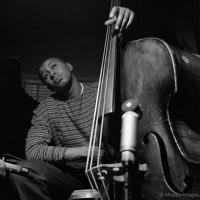Paul Chambers
 USAJazz, Bebop
USAJazz, Bebop

 USAJazz, Bebop
USAJazz, BebopIn the 1950s and 1960s, jazz bassist Paul Chambers rose to prominence as a virtuoso player. Chambers, a key role in the development of the bebop style of jazz, which prioritized improvisation, intricate harmonies, and quick tempos, was born in Pittsburgh, Pennsylvania, in the United States. He worked with some of the biggest names in jazz, like as Miles Davis, John Coltrane, and Thelonious Monk, thanks to his avant-garde approach and technical skill.
The smooth, melodic lines in Chambers' playing and his aptitude for improvising in a way that complemented the other band members were the hallmarks of his style. His contemporaries held him in high regard for his timing and rhythmic accuracy. Chambers' contributions to the bebop movement influenced a great number of musicians that came after him, and his influence can be seen in their work.
Despite his away too soon at the age of 33, Chambers' legacy endures thanks to his records and the artists he influenced. His contributions to the genre are evidence of his brilliance and commitment to the art form, and his groundbreaking work in bebop still inspires and influences jazz players today.
American jazz bassist Paul Chambers, from Pittsburgh, is renowned for his contributions to the bebop style. His most well-known songs include "Blue in Green," "So What," "Flamenco Sketches," "Freddie Freeloader," "'Round Midnight," "Milestones," "All Blues," "Stolen Moments," and "My Funny Valentine."
The songs "So What" and "Blue in Green" are two of Chambers' best-known compositions. In "So What," Chambers effortlessly lays down a catchy bassline, and in "Blue in Green," he demonstrates how to use the bass to give a song depth and emotion. Another outstanding song featuring Chambers' soft basslines merging well with the rest of the ensemble is "Flamenco Sketches."
Chambers made significant contributions to bebop and jazz, which will live on throughout the history of music. He has become a popular among jazz fans thanks to his inventive bass playing and versatility. It's certain that Chambers' legacy will endure for a long time given the continued popularity of songs like "So What," "Blue in Green," and "Flamenco Sketches" in today's music.
The renowned jazz and bebop musician from Pittsburgh, United States, Paul Chambers, has never stopped creating classic music for his followers. His most recent album, "The Music You Need (2023)," demonstrates both his musical talent and his capacity to change with the times. From the bouncy songs to the melancholy ballads, Chambers' music never fails to enthrall listeners around.
His most recent song, "Chambers of Vengeance (2022)," is proof that he can write songs that connect with listeners. The record has garnered praise from both reviewers and fans for its soothing instrumentals and appealing beats. Another one of Chambers' singles that has been making ripples in the music business is "I Breathe (2022)." The song's laid-back vibes and soulful lyrics serve as a reminder of Chambers' talent for writing heartfelt songs.
Two of Chambers' most recent albums, "Elegant Evening (2020)" and "Just for Music (2020)," have solidified his position in the music business. These CDs highlight his artistic range and his capacity to produce timeless music. Another song by Chambers that has received a lot of attention from listeners is "After Hours in 1958 (2020)." Smooth saxophone solos and seductive vocals on the track are reminiscent of the heyday of Jazz and Bebop music.
In conclusion, Paul Chambers' music is still captivating and inspiring listeners all around the world. His most recent album and hits are proof of his creative brilliance and capacity to make everlasting music. Chambers' work serves as a reminder of the ability of jazz and bebop music to unite people, from the mellow ballads to the exuberant tunes.
The iconic bassist from Pittsburgh who played jazz and bebop, Paul Chambers, has worked with a number of well-known musicians over the course of his career. His collaborations with Miles Davis, John Coltrane, Cannonball Adderley, and Wynton Kelly on "Freddie Freeloader" and "'Round Midnight" with Red Garland, Philly Joe Jones, and John Coltrane are among his most significant works.
In "Freddie Freeloader," Chambers' bass lines provide the groundwork for Davis and Kelly's piano solos and drive the buoyant tempo with his rhythmic interplay with Jones' drums. One of Chambers' most memorable collaborations, the track's success is a testimonial to the chemistry and musical intuition between Chambers and his collaborators.
As Coltrane's saxophone and Garland's piano solos are juxtaposed against Chambers' bass performance in "'Round Midnight," which is more subdued and gentle, the music is warm and inviting. The song is one of the most cherished jazz ballads of all time because of its understated elegance and emotional depth, which is in large part due to Chambers' superb bass playing.
In addition to these notable projects, Chambers also worked on "Milestones" with Miles Davis, John Coltrane, Cannonball Adderley, and Red Garland, "I Know Why (And So Do You)" with Red Garland, and "Bye Bye Blackbird" with John Coltrane, Red Garland, and Philly Joe Jones. Chambers' contributions to these songs have solidified his reputation as one of jazz's all-time best bassists.
Paul Chambers' condition deteriorated, he fell into a coma for 18 days, and on January 4, 1969, he passed away at the age of 33 from tuberculosis. His heroin and alcohol habits are said to have led to his health issues.
His music appears on over 1,600 album releases.
April 22, 1935
Paul Chambers played double bass in the world of jazz.
Paul Chambers played with John Coltrane and his Miles Davis bandmates for this Blue Note Record.
He lived in Detroit after moving there to live with his father in 1948.